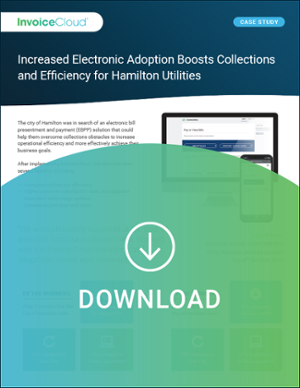For many utility companies, billing customers and collecting payments can be a challenge. Specifically, organizations struggle with keeping costs down and improving efficiencies as a result of:
- High costs associated with printing and mailing a large number of paper bills
- Significant amounts of time spent manually collecting and processing payments
One key way to combat these cost and efficiency issues is through higher rates of electronic payment adoption. Electronic payment (or e-payment) adoption can refer to many things — but for most billing organizations, the most desirable state is for customers to both go paperless (enroll in electronic billing) and sign up for automatic electronic payments, frequently referred to as auto pay.
But how exactly does encouraging customers to go paperless translate to positive business results for your organization? Here’s an example of how one of InvoiceCloud’s clients, Hamilton Utilities, significantly increased customer satisfaction and collections efficiencies, while reducing costs, due to higher e-payment adoption.
Challenges with Paper Billing and Collections
With a population of approximately 63,000, the utility services business division of Hamilton, Ohio — Hamilton Utilities — was printing and mailing paper bills to a large number of customers every month. This created several obstacles for the utility company, including:
- Delayed collections
- High costs of printing and mailing paper bills
- Too much staff time being used to take and process payments
Hamilton Utilities needed an electronic payment solution that could more effectively help them achieve their business goals, while providing the kind of customer experience that would encourage utility customers to go paperless. This meant simplifying the user experience and providing customers with innovative technology that wouldn’t drain their internal IT resources every time a new update or security patch became available.
Helping Customers Go Paperless
The challenge with many online payment solutions is that they offer a clunky user interface that customers find difficult to use – which results in low e-payment adoption rates. E-payment adoption is important, because if customers don’t use the electronic payment platform to pay their bills, it’s difficult for utilities and other organizations to fully realize the benefits of this type of solution.
When customers go paperless, it decreases print and mail costs and the manual time staff has to spend mailing bills. Beyond that, when customers pay their bills online or enroll in services like auto pay, it speeds the collections process, freeing up staff time to focus on other, high value projects.
In the case of Hamilton Utilities, implementing InvoiceCloud’s high-adopting electronic payment platform generated immediate results, including:
- Increased self-service and higher customer satisfaction rates
- Improved staff efficiencies
- Decreased print and mail costs
- Decreased customer churn
How to Make Paperless Work for Your Organization
Hamilton Utilities is a great example of how implementing a well-designed electronic payment solution can encourage customers to go paperless and provide numerous benefits for both customers and staff. To read the full case study, download below.
To learn more about how InvoiceCloud can improve your customer experience through higher e-payment adoption rates, schedule a demo today.

